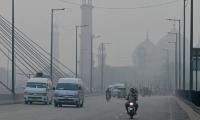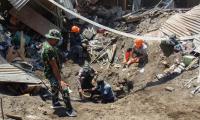Islamabad : Acute respiratory infections classified as upper respiratory tract infections and lower respiratory tract infections including pneumonia have taken shape of an epidemic in this region of the country as currently, almost every second child patient being presented to a public or private healthcare facility is suffering from some of the respiratory tract infection.
Data collected by ‘The News’ on Saturday has revealed that well over 50 per cent of all child patients reaching the allied hospitals in Rawalpindi are with ARIs and the burden of child patients is continuously on the rise. The number of child patients with pneumonia is also registering a sharp increase.
The burden of child patients at the hospitals is much higher because the majority of patients being presented with pneumonia requires indoor treatment at the paediatrics departments. It is worth mentioning here that pneumonia, considered as the major killer of children, kills well over 90000 children in Pakistan every year.
It is time for parents to take extraordinary preventive measures to safeguard their children from ARIs that are hitting child population much severely, said President Pakistan Paediatrics Association Federal Branch Professor Dr. Tariq Saeed Sheikh while talking to ‘The News’ on Saturday. He added that 50 to 60 per cent of all child patients reaching healthcare facilities are with ARIs while over five per cent with severe pneumonia requiring indoor treatment.
Studies reveal that upper tract respiratory infections are the most common infectious diseases. They include rhinitis (common cold), sinusitis, ear infections, acute pharyngitis or tonsillopharyngitis, epiglottitis, and laryngitis – of which ear infections and pharyngitis cause the more severe complications, deafness and acute rheumatic fever, respectively.
Most of the upper RTIs are self-limiting though their complications are more important than the infections, said Dr. Sheikh. ARIs are responsible for almost 20 per cent of all deaths of children aged less than five years worldwide.
He explained that severe pneumonia has respiratory distress, fast breathing and lower chest wall indrawing. Refusal to feed or poor feeling is another important feature. Clinically it is easy to pick pneumonia that has main symptoms of fast breathing and lower chest wall indrawing. Mothers can pick pneumonia by just counting the respiratory rate of the child in one minute and if it is greater than 60 till two months of age, greater than 50 from 2-12 months, and greater than 40 from 1-5 years, the child must be brought to a hospital, he said.
It is important that severe pneumonia is common in infancy and at this age mortality is also high. Experts believe that the cough syrups and flu medicines available in markets for adults are not recommended for use in children under five years of age. They may be dangerous. Paracetamol for fever, saline nasal drops for nose block and home safe cough remedies for cough can be given. Protect children from cold weather. Breastfeeding and vaccination will protect children from pneumonia.
Dr. Sheikh said that children below five years of age must be administered pneumococcal vaccine and haemophilus influenzae type B (Hib) vaccine which is available under Expanded Program on Immunization. Both the vaccines are available at the public sector hospitals free of cost, he said.
Chairman of Prime Ministers Youth Programme Rana Mashhood Ahmed Khan witnessed the letter of intent signing ceremony...
This image shows Rawalpindi Police officials interacting with each other on November 30, 2023. — Facebook/Rawalpindi...
Representational image shows a man walks with sacks of supplies on his shoulder to deliver to a nearby shop at a...







